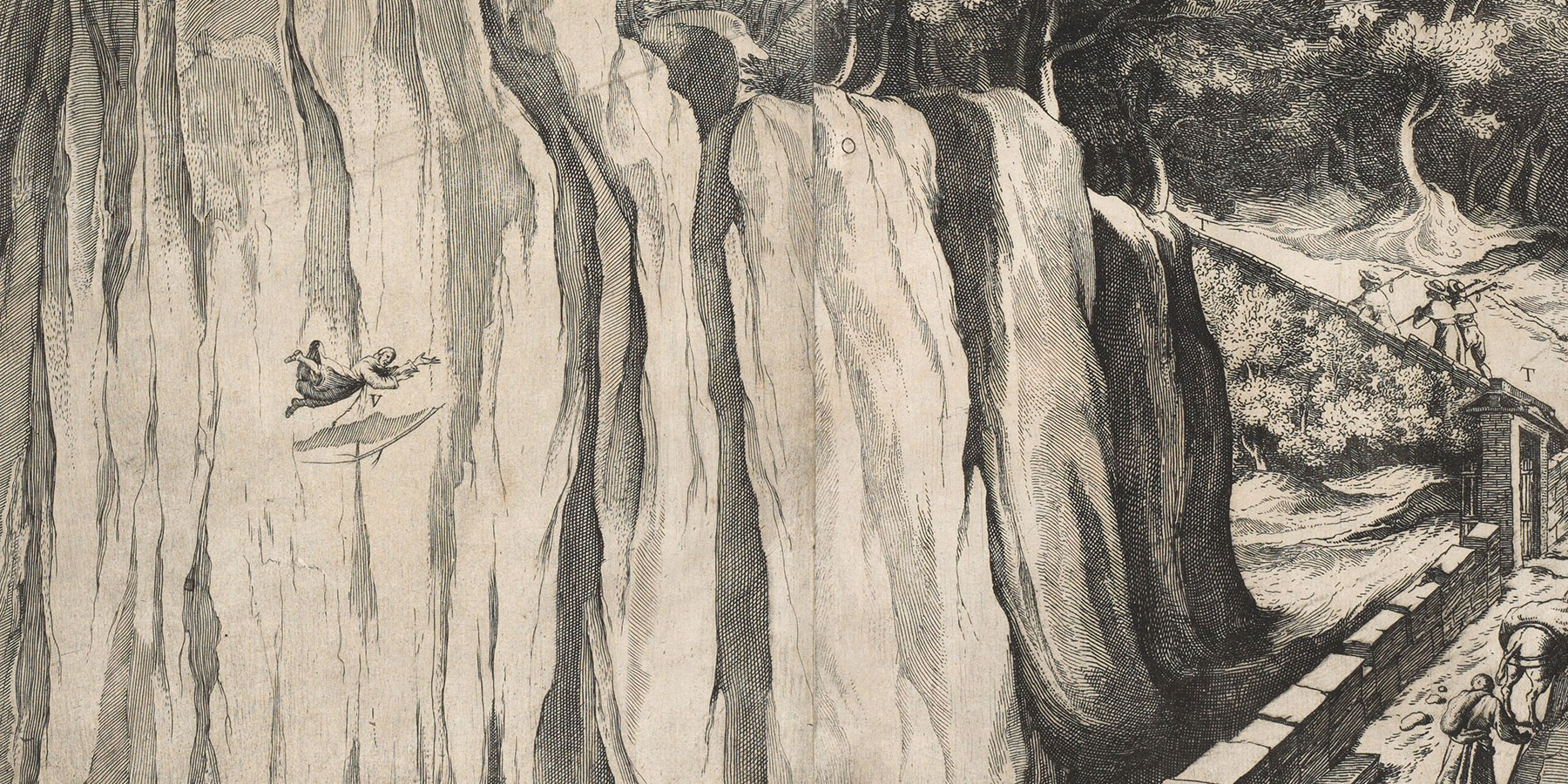In 1213 Count Orlando Catani of Chiusi gave Francis a mountainous parcel of land called La Verna to use as a place of retreat. Tucked into the wilderness east of Florence, La Verna features a solitary peak, known as Monte Penna, and is covered with a forest of beech and fir trees. The friar withdrew to this mountain with his companion Brother Leo in September 1224 for a 40-day fast and contemplation of Christ’s Passion, during which he prayed fervently to share in Christ’s suffering. According to early accounts, the answer to his prayer came in a vision of a fiery six-winged angel, or seraph, bearing the image of Christ crucified. As the seraph departed, the wounds of Christ’s crucifixion, called the stigmata (nail marks through the hands and feet, a piercing of the torso), appeared on Francis’s own body. He bore those wounds for the remaining two years of his life. Today the Sanctuary of La Verna remains an active monastery and, after Assisi, is the second-holiest site for the Franciscan order.
This feature explores Descrizione del Sacro Monte della Vernia, an illustrated volume about the Franciscan Sanctuary of La Verna in Italy, published in 1612 in Florence. The book is the centerpiece of the exhibition Heavenly Earth: Images of Saint Francis at La Verna, on view from February 25 to July 8, 2018.
Saint Francis and the History of La Verna
Francis of Assisi (1181/1182–1226) is known for embracing the divine qualities of the physical world as evidence of God’s design. One of his most famous writings, the Canticle of the Sun (Laudes Creaturarum, or Praise of the Creatures), is a song written in the Umbrian dialect of Italian—rather than in ecclesiastical Latin—which made it widely accessible. The song praises God for the gifts of the sun, wind, fire, and so forth, all of which are tenderly referred to as brothers or sisters. These simple yet powerful expressions of divine love, combined with Francis’s strict adherence to a life of poverty and humility, helped drive his popularity among the laity.

The cliff facade at La Verna, Italy

Domenico Ghirlandaio, Saint Francis of Assisi Receiving the Stigmata (detail), 1483–1486

Domenico Ghirlandaio, Saint Francis of Assisi Receiving the Stigmata, 1483–1486, fresco, Sassetti Chapel, Santa Trínita, Florence
The Franciscan order grew rapidly and set about commissioning the most talented artists of the day to decorate its churches. Before the 17th century, most artists relied on their imaginations to depict La Verna. A rare exception is found in a fresco of Saint Francis receiving the stigmata painted by

Jacopo Ligozzi (designer) and Raffaello Schiaminossi (etcher), Plate A: View of the Mountain of La Verna from the Road of Casentino, in Fra Lino Moroni, Descrizione del Sacro Monte della Vernia (Florence, 1612), National Gallery of Art, Washington, Acquisition funded by a grant from The B. H. Breslauer Foundation, 2013.67.9.2
An Introduction to the Volume
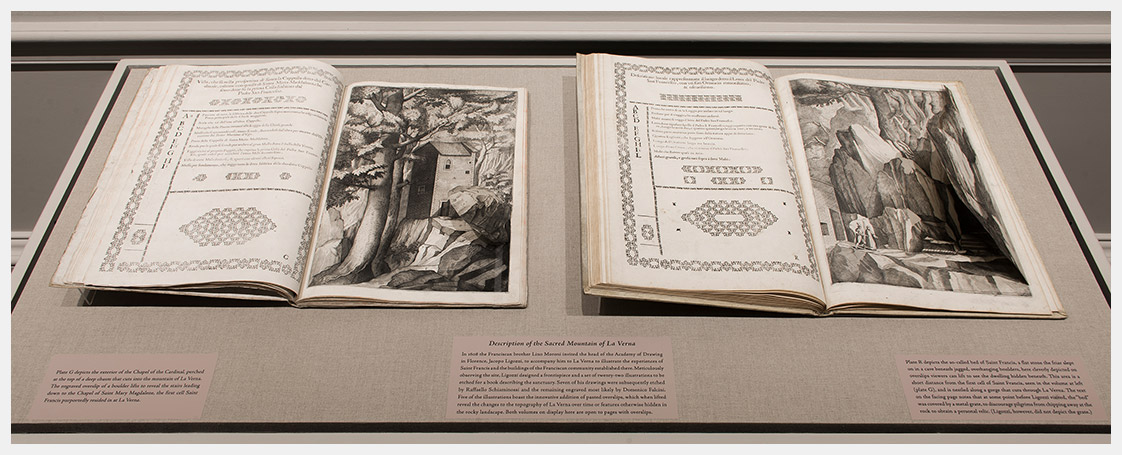
In 1608 the Franciscan brother Lino Moroni invited Jacopo Ligozzi (1547–1627), a gifted draftsman who was the head of the Academy of Drawing in Florence, to accompany him to La Verna. Moroni commissioned Ligozzi to illustrate the experiences of Saint Francis on the mountain, as well as to render the breathtaking topography of the site. Ligozzi’s drawings, subsequently etched by
Each illustration includes a lettered key so readers can explore the topographical features and their associated stories. In addition, Ligozzi designed overslips for several illustrations, which when lifted reveal another view hidden beneath. In some cases these overslips are arranged in a before-and-after fashion; in others, they reveal what is otherwise hidden from view by the boulders and cliffs of La Verna. The accuracy with which Ligozzi rendered the site is remarkable: he made careful measurements when creating his designs, noted in “arms lengths” in the key to several illustrations.
Plates
Plate C: Salute of the Birds
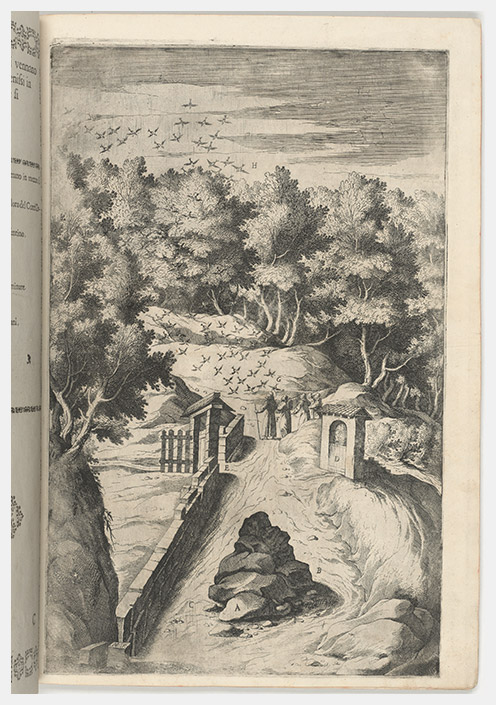
Jacopo Ligozzi (designer) and Raffaello Schiaminossi (etcher), Plate C: The Salutation of the Birds, in Fra Lino Moroni, Descrizione del Sacro Monte della Vernia (Florence, 1612), National Gallery of Art, Washington, Acquisition funded by a grant from The B. H. Breslauer Foundation, 2013.67.9.4
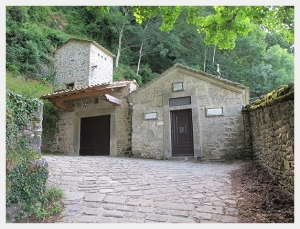
The Chapel of the Birds, La Verna, Italy
This scene narrates the story of Saint Francis’s first visit to La Verna. As he climbed the hill with his companions, they were greeted by a large flock of birds of different varieties. The Chapel of the Birds was erected in 1602 to mark the location of this event.
Plate D: View of the Quadrant: the Main Door, the Square, the Church and the Loggia of the Monastery

Jacopo Ligozzi (designer) and Domenico Falcini (attributed engraver), Plate D: View of the Quadrant: the Main Door, the Square, the Church and the Loggia of the Monastery of the Monte della Vernia, engraving on two sheets pasted together vertically, in Fra Lino Moroni, Descrizione del Sacro Monte della Vernia (Florence, 1612), National Gallery of Art, Washington, Acquisition funded by a grant from The B. H. Breslauer Foundation, 2013.67.9.5

Entrance gate to the Sanctuary of La Verna, Italy
The translated text above the historical entrance, incised in Latin and Italian, reads: “Not in all the world is there a more holy mountain.”

Basilica of Madonna Assunta with bell tower, La Verna, Italy
Ligozzi would not have had this sweeping view of the monastery; the cliff that rises up to the entrance gate prevents such a panorama. Instead he must have studied the various structures from different angles and then assembled the entire view. In some examples of this volume (such as the above), the two engravings were somewhat awkwardly pasted together to create a foldout view of the piazza, churches, and surrounding monastic buildings. In other examples, the two illustrations were bound as separate pages.
The flag hovering prominently in the lower left foreground of the print depicts the Paschal Lamb, a representation of Christ in the form of a lamb with a halo, gripping a banner with a cross. This is the heraldic symbol for the Florentine wool guild (Arte della Lana) that funded the completion of the large church in 1509.
Plate I: The Prominent Rock (Sasso Spicco)
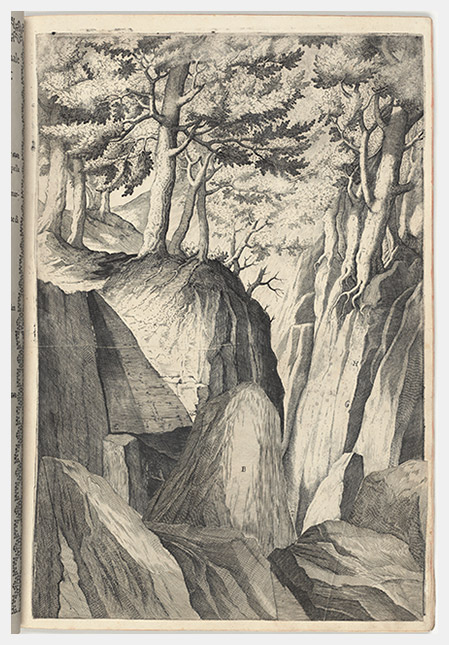

Jacopo Ligozzi (designer) and Domenico Falcini (attributed engraver), Plate I: The Prominent Rock, engraving with engraved overslip, in Fra Lino Moroni, Descrizione del Sacro Monte della Vernia (Florence, 1612), National Gallery of Art, Washington, Acquisition funded by a grant from The B. H. Breslauer Foundation, 2013.67.9.10. Shown here with overslip laid down (left) and lifted (right).

The Sasso Spicco, La Verna, Italy
Beneath this dramatically overhanging boulder, called the Sasso Spicco, Saint Francis spent time in prayer and had the revelation that an earthquake at the moment of Christ’s crucifixion had created the fissures and broken stones of the mountain. The wooden cross depicted in the print can still be seen under Sasso Spicco to mark the spot of Francis’s vision, which linked La Verna to the hill of Golgotha where Christ died.

The Sasso Spicco, La Verna, Italy
Plate R: The Bed of Saint Francis


Jacopo Ligozzi (designer) and Domenico Falcini (attributed engraver), Plate R: The Site of the Bed and Oratory of Saint Francis, engraving with engraved overslip, in Fra Lino Moroni, Descrizione del Sacro Monte della Vernia (Florence, 1612), National Gallery of Art Library, David K. E. Bruce Fund, 2012. Shown here with overslip laid down (left) and lifted (right).
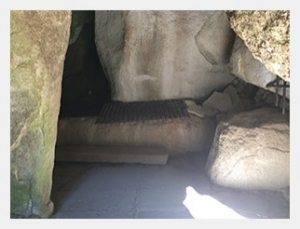
Bed of Saint Francis, La Verna, Italy
Plate R shows the so-called bed of Saint Francis, a flat stone he slept on in a cave beneath jagged, overhanging boulders, here cleverly depicted on overslips viewers can lift to see the craggy dwelling hidden beneath. This area is nestled along a gorge that cuts through La Verna. The key for this illustration explains that at some point before Ligozzi visited, the “bed” was covered by a metal grate, to discourage pilgrims from chipping away at the rock to obtain a personal relic. (Ligozzi, however, did not depict the grate.)
Plate O: The Temptation of Saint Francis
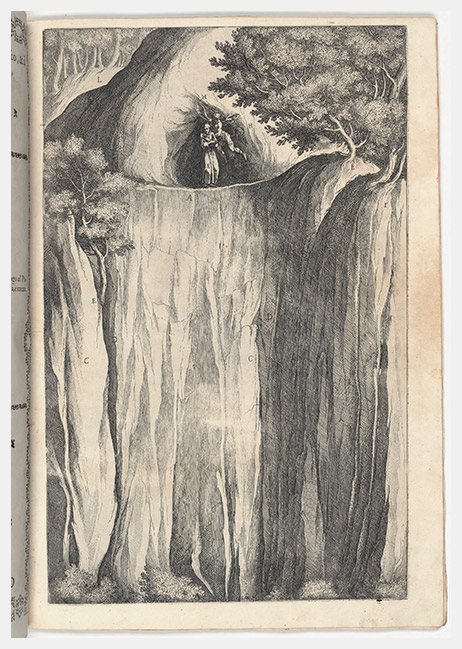
Jacopo Ligozzi (designer) and Raffaello Schiaminossi (etcher), Plate O: The Temptation of Saint Francis, etching and etched overslip, in Fra Lino Moroni, Descrizione del Sacro Monte della Vernia (Florence, 1612), National Gallery of Art, Washington, Acquisition funded by a grant from The B. H. Breslauer Foundation, 2013.67.9.15. The overslip is missing in this copy.

Jacopo Ligozzi (designer) and Raffaello Schiaminossi (etcher), Plate O: The Temptation of Saint Francis, etching and etched overslip, in Fra Lino Moroni, Descrizione del Sacro Monte della Vernia (Florence, 1612), National Gallery of Art Library, David K. E. Bruce Fund, 2012. Shown here with overslip laid down.
This print illustrates an episode from The Considerations on the Holy Stigmata, a chapter appended to the 14th-century collection of stories from the life of Saint Francis, titled The Little Flowers of Saint Francis. In the story, Francis was said to have struggled with the devil atop the precarious rock cliff of La Verna. When it seemed the devil would succeed in throwing Francis from the cliff, the rock softened to receive and protect the friar, leaving a permanent concave shape in the rock.
The site was later safeguarded with a visitor railing, which was included in Ligozzi’s design as a liftable overslip so that viewers might imagine how frightening the cliff is without the guardrail.


The left image looks down from a precipice in La Verna; a close up of the guardrail is on the right. Ligozzi’s design excludes the Chapel of the Stigmata (seen behind the precipice), because the incident with the devil predated Francis receiving the stigmata.
Plate M: The Chapel of the Stigmata
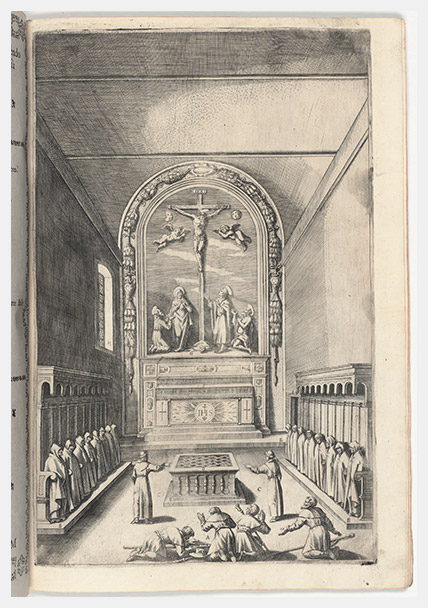
Jacopo Ligozzi (designer) and Domenico Falcini (attributed engraver), Plate M: Church of the Stigmata, in Fra Lino Moroni, Descrizione del Sacro Monte della Vernia (Florence, 1612), National Gallery of Art, Washington, Acquisition funded by a grant from The B. H. Breslauer Foundation, 2013.67.9.13
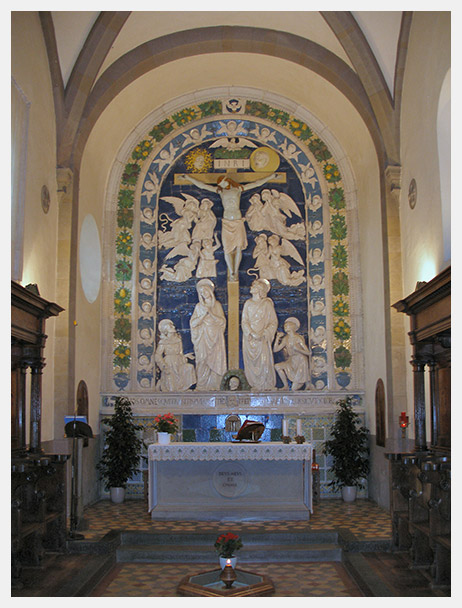
Chapel of the Stigmata, La Verna, Italy
This engraving depicts the interior of the Church of the Stigmata built in 1263 over the exact site where Francis received the stigmata. The protective box shown in the engraving (near the altar on the floor) was later replaced with a hexagonal frame with a glass center (visible in the photo at right). Featured in the room is the magnificent altarpiece by Andrea della Robbia, installed in 1481, the largest Della Robbia terracotta relief ever made, at nearly 19 ½ feet by 14 feet.
The details in the engraving seem hastily completed, which is uncharacteristic of Ligozzi, whose drawing for this design remains unlocated. For example, the curved top of the altarpiece in the engraving awkwardly abuts a flat ceiling. The current groin vault seen in the photograph may have been added later, but even if the original ceiling had been flat, the print presents an unrealistic architectural space, one in which the altarpiece would not have fit. The engraving also omits, changes, or simplifies many details of the actual altarpiece.
Ligozzi’s depictions of other Della Robbia works at La Verna were similarly minimalized or changed for this volume, perhaps because of time constraints or disdain for an earlier ornate style. Whatever the reason, the engraving focuses as much on the figures and their actions as on the decor: two standing friars point to the sacred site of the stigmatization; hooded monks stand respectfully in the choir; and worshipful pilgrims in the foreground are moved by the holy ground on which they kneel—all serve to emphasize the sanctity of this chapel, the most revered site within the Sanctuary of La Verna.
Plate Y: The Stigmata of Saint Francis

Jacopo Ligozzi (designer) and Raffaello Schiaminossi (etcher), Plate Y: Stigmata of Saint Francis, in Fra Lino Moroni, Descrizione del Sacro Monte della Vernia (Florence, 1612), National Gallery of Art, Washington, Acquisition funded by a grant from The B. H. Breslauer Foundation, 2013.67.9.23
The key to this illustration (at left) describes the distance, or height, between the base of the rock and the feet of Saint Francis as being 80 arm lengths (between the letters A in the illustration), and the width as about 60 open arms (between the letters B). Letter C marks the bridge that connected the main mountain to the remote precipice on which Francis was secluded for a 40-day fast. Francis was visited regularly by his close companion Brother Leo, who shields his eyes from the blazing vision of the seraph bearing Jesus on a cross.
